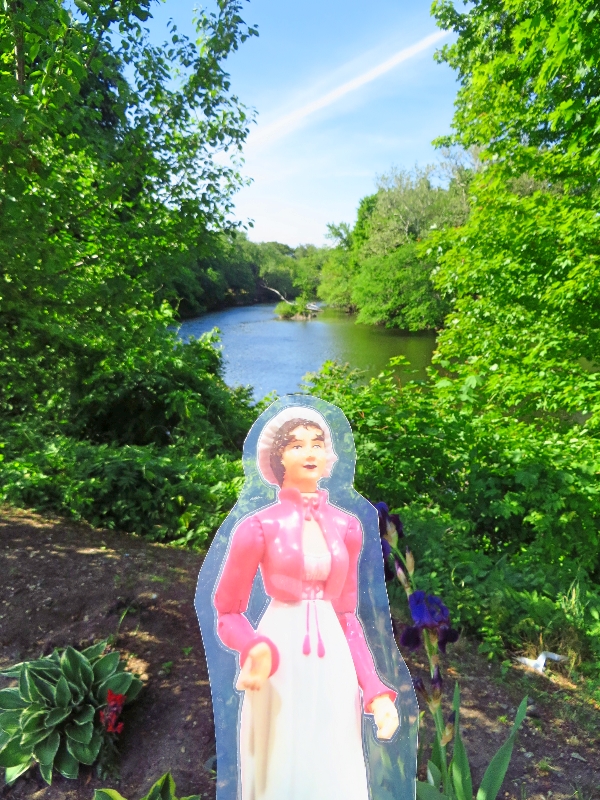Flat Jane Austen in Rhode Island :In Which She Learns of the Industrial Revolution
After our visit with Mr. Slater, we journey up the road to another nearby village. Susanna says Americans do drink tea but sometimes they drink chocolate. As I do enjoy a good cup of chocolate in the morning, I ask to visit the village of Chocolateville where I presume there is a chocolate mill.
Alas we find the chocolate mill is long gone and instead there sits another cotton mill. We tour the site and learn more about the former chocolate mill and current textile mill.
Back in '82, a confectioner named William Wheat erected a mill to process cacao beans into chocolate. Like Mr. Slater, Mr. Wheat used the power of the Blackstone River to grind the beans. It only lasted two years before it fell into disuse.
We learn how the Jencks family owned this land. By the '70s it had been sold to a Mr. Charles Keene who hired Mr. Sylvanus Brown to build a stone and earthen dam across the Blackstone River below a bend in the river which would form a mill pond. Mr. Keene built a mill to manufacture scythes and other farm implements using water power much in the same way as Mr. Slater and Mr. Wilkinson use it in their mill today. The land along the river here in the neighborhood began to be used for industrial purposes.
Not long after, Mr. Wheat erected his chocolate mill. In '84 Mr. Wheat sold off part of his land to Mr. Levi Hall, who turned part of the mill into a manufactory of leather goods. This structure was two storeys high, 20-30 feet in width. The mill was grievously injured in a flood in '07. The mill fell into disrepair and was known as the "Quail's Trap."
Mr. Wheat imported dried cacao from the West Indies. The mill roasted, winnowed and ground the beans into chocolate paste. Sugar and spices were added and the paste was then poured into molds to make the bars we scape for drinking or baking. Mr. Wheat's chocolate was consumed locally. He also produced chocolate for military rations as it has medicinal purposes. Some chocolate may have been sold as shipboard provisions.
Mr. Keene's widow, Mrs. Anne Keene, sold the land back to the Jencks family in '96 and '06. Mrs. Keene and Mrs. Hall owned the water rights as well until '06 when the ladies sold to the Smithfield Manufacturing Co., owned by Mr. Stephen Jencks, Mr. Elisha Waterman, Mr. Rufus Waterman and Mr. Benjamin Walcott. The new owners ceased chocolate production and have outfitted the mill to produce cotton goods.
We survey the river and dam and try to imagine how it must have looked before the mills were built. Perhaps one day the mill will be gone and there will be a park here instead.
 |
| The Blackstone River |
I have crossed my lines, turned my paper and crossed until I am unable to cross any more. I shall leave you here for now and promise to write more soon.
Yours affectionately,
Jane
Learn more about Chocolate Mill Overlook Park in Central Falls, RI
Chocolate Manufacturing in Central Falls (panels)






No comments:
Post a Comment